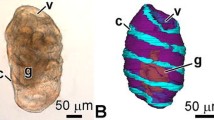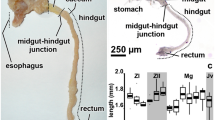Summary
The larval integument of the midge, Chironomus riparius Mg., is unusually thin although it conforms with the normal insect pattern. The cuticle of the post-cephalic segments is about 3 μm thick and overlies an epidermis which has an irregular basal plasma membrane resulting in spaces occurring between it and the basement membrane. The ventral tubuli have a similar epidermis but the cuticle is somewhat thinner. The anal papillae have the thinnest cuticular covering with a uniquely folded epicuticle of variable thickness, and their epidermis has the characteristics of a transporting epithelium. No evidence of pore canals could be found in the cuticle of any part except the head capsule which has a remarkably smooth epicuticle and a distinct layer which may represent the exocuticle. There are no spaces between the basement membrane and basal plasma membrane of the epidermis in the head. Ultrastructural evidence would suggest that gaseous exchange can occur across most of the post-cephalic integument.
Similar content being viewed by others
References
Ashhurst, D.E.: An insect desmosome. J. Cell Biol. 46, 421–425 (1970)
Berridge, M.J., Oschman, J.L.: Transporting epithelia. London-New York: Academic Press 1972
Bouligand, M.Y.: Sur un architecture torsadée répandue dans de nombreuses cuticles d'arthropodes. C.R. Acad. Sci. (Paris) 261, 3665–3668 (1965)
Caveney, S.: Muscle attachment related to cuticle architecture in Apterygota. J. Cell Sci. 4, 541–559 (1969)
Caveney, S., Podgorski, C.: Intercellular communication in a positional field. Ultrastructural correlates and tracer analysis of communication between insect epidermal cells. Tissue & Cell 7, 559–574 (1975)
Cohen, A.L.: Critical point drying. In: Principles and techniques of scanning electron microscopy. Biological applications, Vol. 1 (M.A. Hayat, ed.), New York: Van Nostrand Reinhold 1974
Credland, P.F.: A new method for establishing a permanent laboratory culture of Chironomus riparius Meigen (Diptera: Chironomidae). Freshwat. Biol. 3, 45–51 (1973)
Credland, P.F.: A structural study of the anal papillae of the midge Chironomus riparius Meigen (Diptera: Chironomidae). Cell Tiss. Res. 166, 531–540 (1976)
Fox, H.M.: Methods of studying the respiratory exchange in small aquatic organisms, with particular reference to the use of flagellates as an indicator for oxygen consumption. J. gen. Physiol. 3, 565–573 (1921)
Haas, H.: Der Einfluss der O2-Spannung des Wassers auf die Entwicklung der Tubuli und Analpapillen von Chironomus thummi. Biol. Zbl. 75, 712–732 (1956)
Harnisch, O.: Die Funktion der präanalen Oberflächenvergrößerungen (Tubuli) der Larve von Chironomus thummi bei sekundärer Oxybiose. Z. vergl. Physiol. 24, 198–209 (1937)
Komnick, H., Wichard, W.: Vergleichende Cytologie der Analpapillen, Abdominalschläuche und Tracheenkiemen aquatischer Mückenlarven (Diptera, Nematocera). Z. Morph. Tiere 81, 323–341 (1975)
Locke, M.: The structure and formation of the integument of insects. In: The physiology of insecta, Vol. VI (M. Rockstein, ed.). New York-London: Academic Press 1974
Locke, M.: The role of plasma membrane plaques and Golgi complex vesicles in cuticle deposition during the moult/intermoult cycle. In: The insect integument (H.R. Hepburn, ed.). Amsterdam-Oxford-New York: Elsevier 1976
Neville, A.C.: Biology of the arthropod cuticle. Berlin-Heidelberg-New York: Springer 1975
Richards, A.G.: The integument of arthropods. Minneapolis: University of Minnesota Press 1951
Spurr, A.R.: A low-viscosity epoxy resin embedding medium for electron microscopy. J. Ultrastruct. Res. 26, 31–43 (1969)
Weibel, E.R., Knight, B.W.: A morphometric study on the thickness of the pulmonary air-blood barrier. J. Cell Biol. 21, 367–384 (1964)
Weis-Fogh, T.: Structure and formation of insect cuticle. In: Insect ultrastructure. Symp. R. ent. Soc. Lond. No. 5, 165–185 (1970)
Wright, D.A.: Sodium regulation in the larvae of Chironomus dorsalis (Meig.) and Camptochironomus tentans (Fabr.): the effect of salt depletion and some observations on temperature changes. J. exp. Biol. 62, 121–139 (1975)
Author information
Authors and Affiliations
Additional information
The author is indebted to Mrs. L. Rolph and Mr. R.L. Jones for their technical assistance
Rights and permissions
About this article
Cite this article
Credland, P.F. An ultrastructural study of the larval integument of the midge, Chironomus riparius meigen (Diptera: Chironomidae). Cell Tissue Res. 186, 327–335 (1978). https://doi.org/10.1007/BF00225541
Accepted:
Issue Date:
DOI: https://doi.org/10.1007/BF00225541




